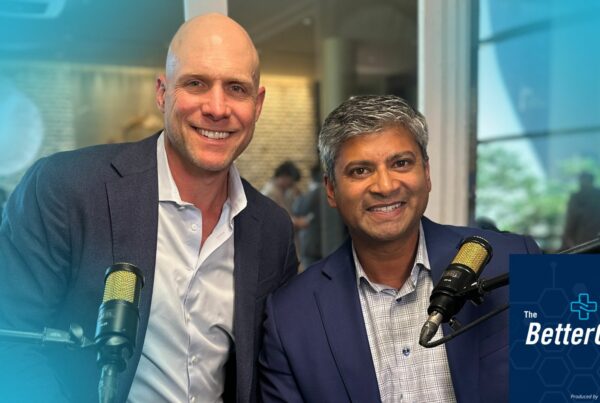During the COVID-19 pandemic, most of us had to endure a new feeling of being disconnected. Disconnected from family, friends, co-workers, and clients. At EvidenceCare, we felt and heard the disconnect in online conversations and webinars, so we decided to create a virtual Fireside Chat event to keep people connected in a more meaningful way than a typical webinar.
What started as a one-off event is now an ongoing intimate and interactive series where we host various healthcare leaders around a specific industry topic.
On our most recent Fireside Chat, we gathered around another topic heavily impacted by the COVID-19 Pandemic – digital transformation in health systems.
According to a recent Deloitte survey on digital transformation, “an executive champion is key to digital transformation success,” so we wanted to hear directly from a group of digital innovation leaders who have successfully implemented digital strategies at their health systems.
Our two panelists for the event were, Bo Wilkes, Managing Director of Ballad Health Innovation Center, and President of Ballad Ventures, and Jim Whitfill M.D., SVP and Chief Transformation Officer at HonorHealth.
The discussion centered around what it looks like to effectively structure innovation and digital roles, titles, and reporting in a health system, and how to successfully implement and execute digital investments in a health system.
How do you effectively structure digital transformation in a health system?
When asked how to effectively structure digital innovation, our attendees shared the different ways they structured titles and roles in their systems to adapt to a new digital environment.
Here were the main takeaways:
Define “Digital”
How your organization defines digital innovation is going to affect how it’s structured and what the different components are. It’s also important to make sure you are receptive to disruption that may come.
Find the right people
Be prepared to work very closely with IT, CIO’s, and CMIO’s and support them with their role in the process. You can even create a committee or sub-committee that is dedicated to innovation and digital success. These groups can include leaders from each vertical of your system and your key end-users to ensure that digital transformation is beneficial to everyone and doesn’t feel forced.
Remember, no one has it perfectly figured out
We might have picked a different topic if they did 🙂
Examine financial return on investment (ROI), but also focus on return on health (ROH), which is the health and wellbeing of physicians and patients.
How do you successfully implement and execute digital investments in a health system?
After discussing the structure, we turned to implementation. Getting internal buy-in to change organization structure is great, but it’s only worth it if digital implementation is successful. Here’s what our attendees recommended:
Allocate funds wisely
It’s great to have a lot of funding to support innovation ventures, but also consider having some set aside for funding pilots. You don’t want to spend all your funding on one major project when you’re just getting started. Pilot opportunities can be a great way to help weigh if certain digital tools will meet your system needs. Be open to strategic relationships that you can invest in. Collaboration is key.
Examine the core functions of Digital Transformation
Investment- What is the investment?
Innovation- How is it going to be innovative?
Adoption- What does adoption look like?
Scaling- Could we eventually scale?
Look into the future, not just “next week”
It’s easy to only focus on the near future, but it’s crucial to analyze the long-term effects of pursuing an investment. One of our participants even suggested to “view digital transformation as creating alternative value.”
Finding the right fit
Stay in the know by having your committees focused on watching the digital marketplace to help create goals specific to need, drive the process, and bring portfolios to the table. Make sure you’re partnering with companies who have a viable product and proof of concept.
“IT was the old model, which is a utility approach: we bring function to your doorstep, and you do the rest. Versus digital, which is what we’re doing today around new platforms, new channels, and most importantly, working as deep partners with our different clinical and business units.”
-Jim Whitfill, SVP & Chief Transformation Officer, HonorHealth
A consistent theme gathered from the discussions was to examine financial return on investment (ROI), but also focus on return on health (ROH), which is the health and wellbeing of physicians and patients. Recognize that not every fit is perfect. Some digital innovation may be great and work wonders for some systems, but may not fit will with your system’s needs, and that is okay.
“We’ve developed a structure working very closely with our CIO, CMIO, and our Chief Consumer Officer to develop an entry point for transformation. It doesn’t require physicians and executives to look across the organization and try to figure out, where does it fit? How do I get adoption? How can I get IT staff budgeted and develop a business plan around it? It becomes a natural entry point. My role on the innovation side is to help with that entry point. My goal is to develop the business strategy, pilot it, and then, if we’re successful, try to scale across the organization.”
-Bo Wilkes, Managing Director of Ballad Health Innovation Center, President of Ballad Ventures
Creating Digital Transformation at Your Health System
We hope these insights from our conversation were helpful as you navigate digital transformation at your health system. If you’d like to join one of our future Fireside Chat events or learn more about how EvidenceCare can help with your digital transformation efforts, please contact us here.









